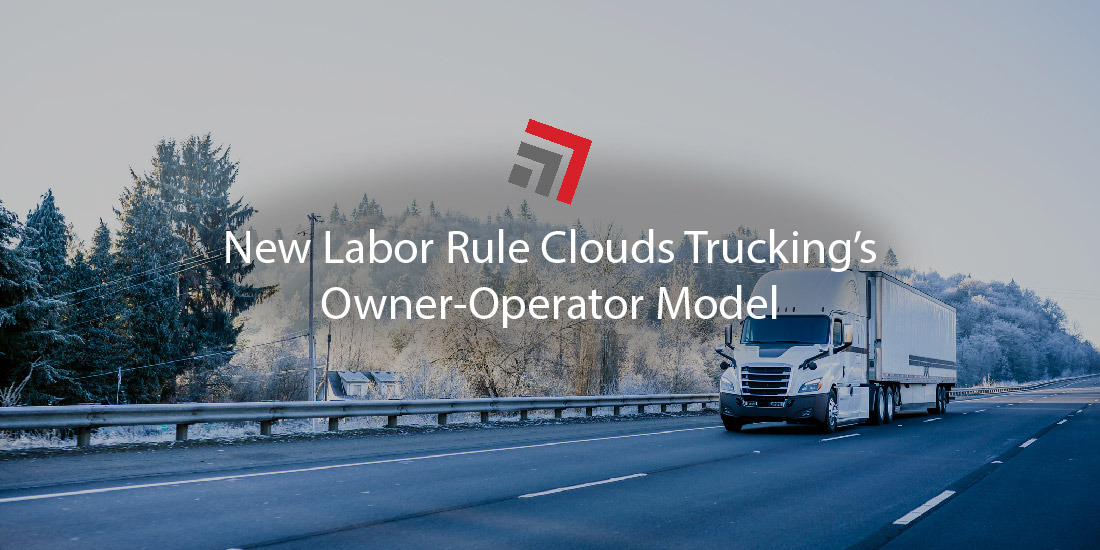Sweeping legislation from the Department of Labor was enacted by the Biden administration last Tuesday. The labor rule is designed to prevent workers from being misclassified as independent contractors.
The final ruling strokes a broad brush across America’s labor force. From home health care providers to Uber drivers, previously defined independent contractors could be reclassified as employees. This means they’d be entitled to a minimum wage and overtime pay, while eligible for benefits (insurance, social security, etc.,)—guarantees otherwise not available to workers under independent contractor status.
The rule particularly concerns the trucking industry. Stakeholders are vehemently opposed as it creates uncertainty for truck drivers and the companies that employ them.
Independent contractors represent good share of drivers
There are some 350,000 professional truck drivers (including drayage) who work as independent contractors. Otherwise known as owner-operators, these drivers are apart of a popular business model in the industry. Under contractor status, an owner-operator is not employed by a singular trucking company. Rather, they are own their boss, set their own hours, and choose individual jobs (loads) from an open market of trucking companies.
However, the rule’s language implies it’ll be much more difficult for trucking companies to protect the independent contractor status of owner-operators who contract with them. They fear that they’ll have to adjust their working relationship with drivers to an employee model—the likes of which upset both sides.
An employer-employee relationship would place the onus on trucking companies to pay drivers full-time (or part-time) wages and provide certain benefits. They would also be responsible for covering other costs, like vehicle and equipment expenses. In the contractor model, owner-operators own, or lease,their vehicles and pay for their equipment. This is by far the largest expenditure independent drivers face. Under the new rule, trucking companies could be the ones footing the bill though.
On the driver front, owner-operators are also heavily against the rule. While the job as an owner-operator is a risky venture, many drivers prefer it over traditional employment as they have full-autonomy over their hours and jobs. When the rule was proposed last year by the labor department, many of them have lambasted the legislation as a job killer and a similar beast to California’s controversial AB5 law.
Trucking responds to the rule
In response to the rule’s enactment, several leaders of prominent trucking associations have voiced their objections.
Owner-Operator Independent Drivers Association (OOIDA) President and CEO Todd Spencer asserted that the rule disregards specifics related to the trucking industry—potentially leading to a reclassifying from contractors to employees. “Truckers are tired of the endless parade of classification rules that do not listen to their concerns,” he said. “This constantly changing landscape has created uncertainty that makes it more difficult for them to operate their businesses.”
Spencer added that any labor classification rule must allow for owner-operator relationships to be examined on a case-by-case basis. OOIDA will continue to review the final ruling and engage with federal regulators over the decision.
Other leaders have described the rule as burdensome for both domestic and intermodal trucking. 80 percent of drayage drivers are currently operating as independent contractors, according to the Intermodal Association of North America.
In typical Chris Spear fashion, American Trucking Associations President and CEO Chris Spear offered a coarse assessment of the rule: “I can think of nothing more un-American than for the government to extinguish the freedom of individuals to choose work arrangements…More than 350,000 truckers choose to work as independent contractors…enabling them to run their own business and choose their own hours and routes.
The ATA leader added that the contractor model has been integral to the industry’s success since the inception of interstate trucking. He vowed that the association “will work with members of Congress and other stakeholders to defeat this ill-advised rule.”
Contractor status must be proven otherwise
The rule contains six criteria in which companies can otherwise prove independent contractor status of a worker. Not all of the criteria must be met, however more than half must be satisfied. In other words, the rule doesn’t outright ban the contractor model—it just makes upholding it more difficult.
Essentially, contractor status is now the exception to the rule. Unless demonstrated otherwise, employee status is the default moving forward.
Like the trucking industry, ride hail is in opposition of the new rule. The Flex Association, which represents Uber and Lyft, issued a statement last Tuesday following the enactment: “Independent work has become an indispensable part of the nation’s economy. While we do not anticipate immediate impacts, the Department of Labor’s new guidance could generate significant uncertainty for millions of small business owners and entrepreneurs.”
The enacted labor rule overrides a Fair Labor Standards Act rule passed during former President Donald Trump’s administration. The previous rule, adopted in March 2021, made it easier for employers to classify workers as independent.
Final Thoughts
Labor advocates say the new rule offers better standing for determining whether independent workers are truly in business for themselves and not being exploited by companies contracting them. In other words, they argue that the rule targets businesses who take advantage of misclassifying workers to shirk accountability.
This point is fascinating to consider when applied to the trucking industry. If asked, it’s likely that the majority of owner-operators would respond they’re under contractor status for their own personal gain and preference.
Please contact us if you have any questions regarding this topic or any others in domestic logistics.
More blogs similar to this:



Recent Comments